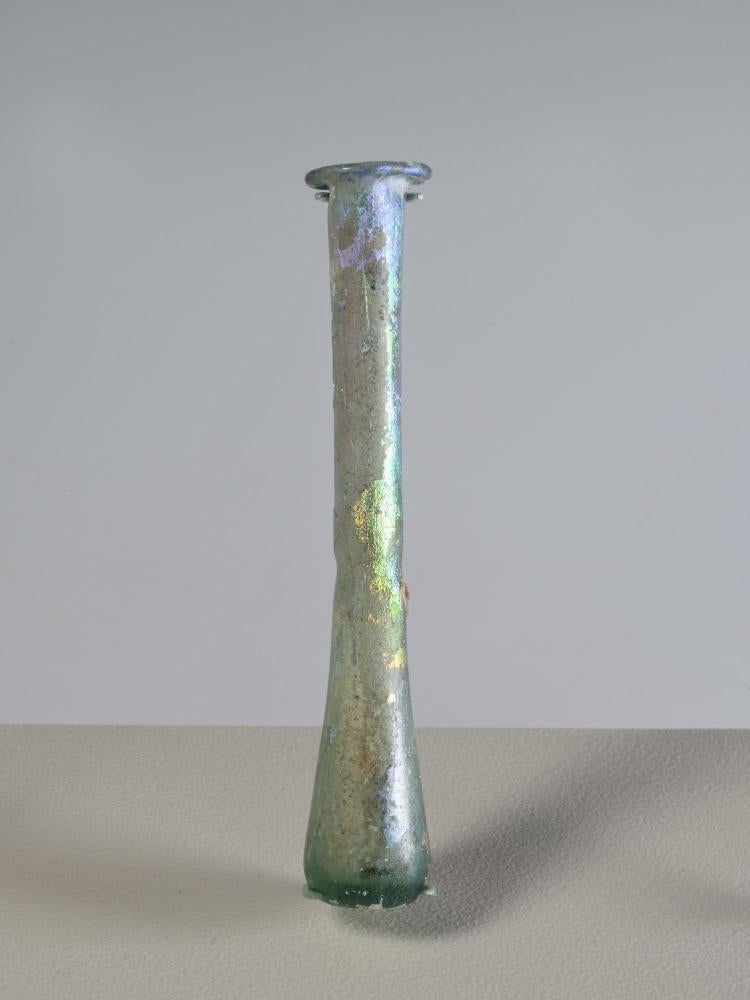2008.18.2.9, Roman Candlestick Unguentarium
Catalogue Entry 

From the Catalogue of Ancient Glass in the University of Colorado Museum
Gift of H. Medill Sarkisian and Justine Sarkisian Rodriguez (1979)
Transferred to CU Art Museum (2008)
Height: 11.2 cm
Diameter (max.): 1.9 cm
Roman, Late 1st century C.E.
Classification: Isings Forms 8; Harden Fabric 9
Description: Rounded rim, folded in. Tall cylindrical neck flares at both ends. Slight constriction toward base of neck. Smooth transition to base with slightly flared straight walls. Base concave. Green. Iridescence near rim and central constriction, with a pale residue inside. Modern metal stand, glued to base. Blown.
Comment: Vessels of this type appear as early as Augustan times at Magdalensberg, Austria, and in the second half of the 1st century C.E. they become very numerous. For example, large quantities of them have been found at Pompeii and Herculaneum. The fabric of this specimen is suggestive of mass production, which supports a late 1st century C.E. date. Similar examples include Hayes 1975, nos. 235, 570, 630, and 666; Fitzwilliam Museum 1978, no. 64b; Fleming 1996, fig. 16; and Whitehouse 1997, nos. 228 and 241.
The metal stand affixed to the vessel and the and the residue inside may be evidence that this unguentarium was once used as an inkwell.
Discussion
The green color of this vessel comes from a small amount of natural metal in the ingredients. All sand used for making glass has a very small percentage of metals in it. Green glass is caused by one to three percent of iron mixed in with the sand. It is uncertain how much the ancient Roman glassmakers could control the tint of the glass, but they knew which metals caused which colors (1). During the height of the Roman Empire, colorless glass became more and more desirable. The less tinted the glass was with color, the more expensive (2).
An unguentarium was used to hold scented oil, perfume, or body lotion used by both men and women. These cosmetics were applied as soon as one awoke, then again after they bathed during the day at the local bathhouse. The most popular scents were saffron, marjoram, and roses, according to Pliny the Elder, a 1st century C.E. Roman author (Natural History XIII.2). Inscriptions from ancient towns such as Pozzuoli indicate that the perfume-makers were usually in the same district as the glassworkers, suggesting that craftworkers realized the efficiency of being near a business they were closely connected to (3).
Footnotes
- Donald B. Harden, Roman Glass from Karanis (Ann Arbor: University of Michigan Press, 1936): 6-9.
- Hugh Tait, ed. Five Thousand Years of Glass (Philadelphia: University of Pennsylvania Press, 1991): 79-82.
- Stuart J. Fleming, Roman Glass: Reflections of Everyday Life (Philadelphia: University of Pennsylvania Museum, 1997): 28-31.
References
- Fleming, S. J. “Early Imperial Roman Glass at the University of Pennsylvania Museum,” Expedition 38.2 (1996): 13-37.
- Glass at the Fitzwilliam Museum. Cambridge: Cambridge University Press, 1978.
- Hayes, J. W. Roman and Pre-Roman Glass in the Royal Ontario Museum. Toronto: 1975.
- Whitehouse, D. Roman Glass in the Corning Museum of Glass, v. 1. Corning, NY: Corning Museum of Glass, 1997.

